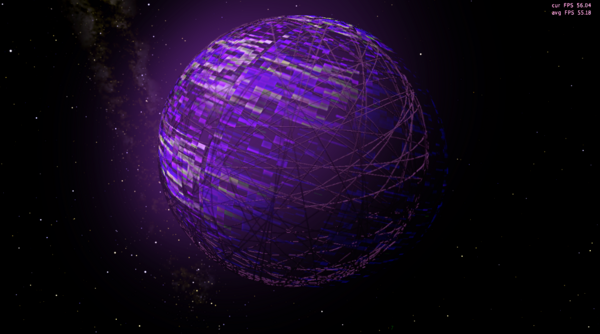Jupiter Brains (A1-0)

A Jupiter Brain (also known as a J-Brain) is a computational substrate megastructure, comparable in mass and size to a gas giant planet, typically in the 1x1027 kilogram range. Due to the required amount of resources, they are very rare, with only a couple of them existing in the Galactyan Empire.

Structure
The computronium basis of a modern Jupiter Brain usually consists of a colloidal structure of Plasma, Low Density Monopolium, Diamondoid and Feroid, that form a network of nodes around a central energy core consisting of Quantum Dot Circuits (QDC) and Molecular Storage Systems (MSS). Each node acts as a processing element, a memory storage system, or both, meant to act with relative independence. Internal connections between the nodes are optical, employing fiber optics, waveguides and utilizing directional signals sent through vacuum. Around the sphere is located either a concentric shield and/or a series of looping structures whose function would be to dissipate heat into space via radiation.
Due to their massive size, Jupiter Brains can only sustain themselves from collapsing thanks to the
Heat dissipation is often a major concern with Jupiter Brains; the denser they are, the faster they can run, due to the distances involved in transmitting internal data. But increasing the density of the computronium also increases the problems associated with the heat of operation. The number of computations that a Jupiter brain performs in a given time is directly related to the amount of waste heat the brain must emit, and since this heat must be emitted at the surface of the structure, very often a J-brain has a very large external radiating surface which helps to cool the object.
Jupiter Brains mainly receive the energy needed for their computation from the same partial Dyson Swarms that were used for their construction. Other sources of energy include both on-site fusion and antimatter reactions, although these tend to be short-term methods.
Some Jupiter Brains are sufficiently luminous to act as the center of a system of habitable moons or other megastructures, which gather the waste heat given off by such an object through orbiting photovoltaic systems to provide energy for their environment. Examples of this are the Provius Jupiter Brain and the Abyx River Jupiter Brain.
Construction
Self-replicating nanomachines are introduced inside of a selected gas giant, and are provided energy for replication by a partial Dyson Swarm in orbit of the gas giant's primary star. The nanomachines, coupled with specialized nanofabricators then start to convert, refine and reorganize the gas giant's matter into the colloidal structures that make up the computronium basis of the Jupiter Brain. Then, the colloidal structures are connected between one another, first forming the central energy core's QDCs and MSSs, followed by the rest of the nodes network. The radiator shields and loops are then optionally constructed if the structure is supposed to be a high activity J-Brain. The entire process for the creation of a Jupiter Brain takes around a decade to be fully completed and operational, due to the internal complexity of the megastructure.